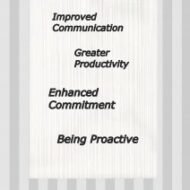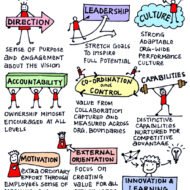Posted by Managementguru in Strategy
on Mar 2nd, 2015 | 0 comments

Advantages of Strategic Management A couple of definitions on STRATEGIC MANAGEMENT Strategic management involves formulation and implementation of the major goals and plans taken by a company’s top management on behalf of owners, based on consideration of resources and an assessment of the internal and external environments in which the organization competes. The methodical analysis of the factors associated with customers and competitors (the external environment) and the organization itself (the internal environment) to provide the basis for maintaining optimum management practices is another well known definition. The objective of strategic management is to achieve better alignment of corporate policies and strategic priorities. Advantages: 1. Discharges Responsibility The process of strategy formulation satisfies the expectation from shareholders, stakeholders and the general public at large, that a strategically managed organization will discharge its duties successfully. 2. Allows an Objective Assessment Strategic management provides a CONTROL that allows the senior management team to take a step back from the day-to-day business and CONTEMPLATE about the future of the organization. 3. Faciliatates to Make Wise Business Decisions Strategy provides the framework within which EXECUTIVES at lower and middle levels can make day-to-day operational decisions that are aligned with the accomplishment of the organization’s goals. 4. Enables Understanding and Improves co-ordination between different departments Allowing participation in the strategic management process enables better understanding of the direction, why that direction was chosen, and the associated benefits. Good strategy formulation and communication process are vital steps in enabling effective and efficient strategy deployment. 5. Simplifies Measurement of Progress Strategy sets the direction and empowers an organization to bring into line its objectives and performance measures. These objectives and performance measures allow meaningful information to be provided to decision-makers regarding the organization’s progress through such tools as scorecards and dashboards. 6. Enhances Strategic Agility (Innovation) When a firm can successfully capitalize upon opportunities resulting from unanticipated and significant change, it is said to be innovative as it has a competitive edge over other firms. 7. Ensures Allocation of Resources: The limited resource is properly allocated to different functional levels so as to create value for all stakeholders. A targeted approach to markets and opportunities obviously strengthens your bottom line. A simple representation will make your understanding better: Enhanced Communication DIALOGUE PARTICIPATION | | Deeper/Improved Understanding OF OTHER’S VIEW OF WHAT THE FIRM IS DOING | | Greater Commitment TO ACHIEVE OBJECTIVES TO IMPLEMENT STRATEGIES TO WORK HARD | | The Result ALL MANAGERS AND EMPLOYEES ON A SINGLE MISSION TO HELP FIRM SUCCEED...

Posted by Managementguru in Change management, Human Resource, Organisational behaviour
on May 20th, 2014 | 0 comments

Organizational Climate – An Analogy Organizational climate is a measure of the feel of the internal environment of an organization which is perceived by an outsider and/or an employee according to their business with the organization. Organizational climate has a great effect on employees’ behavior. If the climate of an organization is open and friendly, employees feel relaxed and if it is very formal, then such a comfort level may not be felt. Climate for an organization is somewhat like personality for a person. “Just as every individual has a personality that makes him/her unique, an organization has a climate that clearly distinguishes its personality from other organizations. Human religionists introduced the concept of organizational climate in the late 1940’s. Now this has become a very useful metaphor for thinking about and describing the social aspects of a firm. Some definitions: “A set of characteristics that describe an organization and that i. Distinguish one organization from another ii. Are relatively enduring over a period of time and iii. Influence the behavior of people in the organization.” – Forehand and Gilmber “A mutually agreed internal (or molar) environmental description of an organization’s practices and procedures.” – Benjamin Schneider (1975) “A relatively ending quality of the internal environment that is experienced by the members, which influences their behavior and can describe in terms of values of a particular set of characteristics of the organization.” – Renato Tagiuri (1968) Features: It is an abstract and intangible concept. But it exercises a significant impact on the behavior and performance of organization members. It is the perceived aspect of organization’s internal environment. It refers to the relatively enduring characteristics which remain stable over a period of time. It gives a distinct identity to organization and differentiates it from others. It is a total expression of what the organization is. It is the summary perception which people have about organizations. It is a multi-dimensional concept. It consists of all organizational factors – authority pattern, leadership pattern, communication pattern, control etc. Elements of Organizational Climate: Individual Autonomy: The extent to which employees are entrusted with to make decisions, the degree to which they are free to manage themselves and have the freedom to exercise their responsibility come under the purview of individual autonomy. Position Structure: It means the extent of direct supervision, formalization and centralization in an organization. Reward Orientation: The degree to which an organization rewards individuals for hard work or achievement. It will be high when an organization orients people to perform better and rewards them for doing so. Task Orientation: If the outlook of the top management is task oriented, the employees will have to speed up the pace of work to please their bosses. Relations Orientation or Consideration: Here the climate is conducive and supportive where the managers are relations-oriented while dealing with their sub-ordinates. The needs and aspirations of the workers will be given due importance resulting in enhanced team spirit. Job Satisfaction: The workers feel happy if the jobs are designed to allow the worker to use their innovative skills. Morale: Morale represents a composite of feelings, attitude and sentiments of organizational members towards the organization, superiors and fellow workers. If it is high, there will be an atmosphere of co-operation and if it is low, there will be conflicts and poor co-operation among the workers. They will also feel dis-oriented in their work. Control: The control systems may be either rigid or flexible. An impersonal or bureaucratic atmosphere is seen in the former situation where the scope of self-regulation will be minimum. DOWNLOAD THE PDF...




